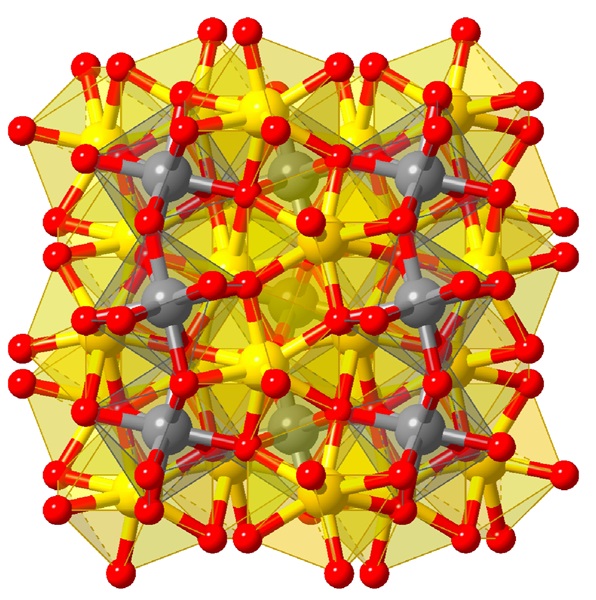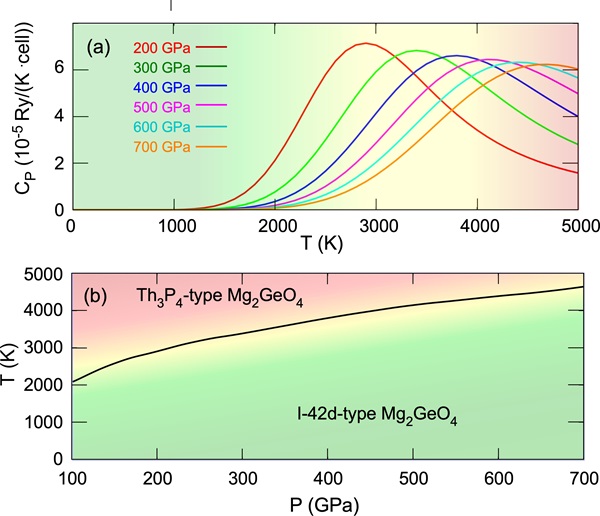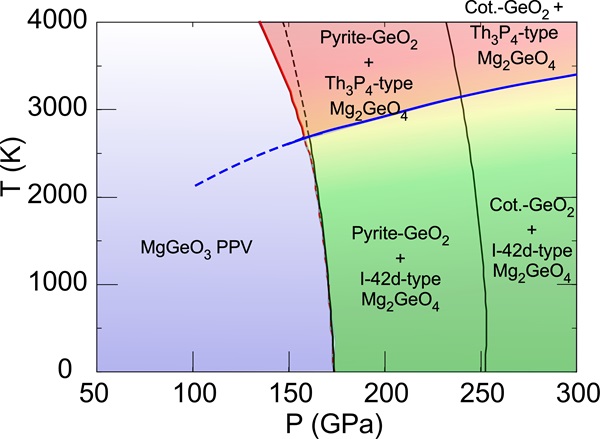In this research, an order-disorder transition in its cation sublattice of Mg2GeO4 between I-42d-type and Th3P4-type phases is predicted using ab initio calculations to occur at high temperatures. This type of uncommon prediction is achieved by carrying out a high-throughput sampling of atomic configurations in a 56-atom supercell followed by a Boltzmann ensemble statistics calculation. Mg2GeO4 is a low-pressure analogue of I-42d-type Mg2SiO4, a predicted major planet-forming phase of super-Earths’ mantles. Therefore, a similar order-disorder transition is anticipated in I-42d-type Mg2SiO4, which should impact these planets’ internal structure and dynamics.

Many candidates of super-Earths, terrestrial exoplanets much larger than the Earth, have been discovered recently. Internal pressures and temperatures in super-Earths should be much higher than those of the Earth. Despite remarkable developments in experimental techniques, these pressure-temperature conditions are still very challenging to experiments making ab initio predictions of phase-transition phenomena in planet-forming phases critical to advancing planetary modelling. So far, several ab initio calculations have predicted that MgSiO3 post-perovskite (PPV), which is the final form of MgSiO3 (a major constituent of the Earth’s lower mantle) in the Earth, should undergo the pressure-induced three-stage dissociations: MgSiO3 PPVà I-42d-type Mg2SiO4 + P21/c-type MgSi2O5 à I-42d-type Mg2SiO4 + Fe2P-type SiO2 à CsCl-type MgO + Fe2P-type SiO2. However, these predictions were based on structural searches at the static condition, i.e., any effect of temperature on the phase transitions has not been considered explicitly. Since the temperature in super-Earths is very high, phase transitions induced by temperature as well as pressure should be investigated.

In this research, a temperature-induced order-disorder transition (ODT) was predicted by ab initio calculations for I-42d-type Mg2GeO4, which is a good candidate for a low-pressure analogue of Mg2SiO4. In I-42d-type Mg2GeO4, local atomic environments around the Mg and Ge sites are very similar, both being surrounded by eight O ions. Due to the similarity, all cations are expected to be distributed randomly over these sites by entropy at high temperatures, leading to the ODT. Once the ODT occurs and all cation sites become equivalent, the resultant structure is identical to that of Th3P4.

The ODT critical temperature, Tc, was calculated using a statistical treatment. To represent the disordered Th3P4-type phase, an ensemble of 125 configurations was generated for a supercell consisting of 56 atoms. Then, the partition function was obtained by taking the summation of Boltzmann factors, whose total energies were by ab initio calculations, over the 125 configurations. From the partition function, the heat capacity, CP (P, T), can be calculated. The peak temperature of CP gives Tc. Since Tc gradually increases with pressure, the phase boundary has a positive Clapeyron slope. With the ODT predicted, a new sequence of the post-PPV dissociation should occur at high temperatures: MgGeO3 PPV à Th3P4-type Mg2GeO4 + pyrite-type GeO2. Since Mg2GeO4 is an analogue of Mg2SiO4, a similar ODT should also occur in I-42d-type Mg2SiO4 at high temperatures and impact the internal structure and dynamics of super-Earths.
| Journal | Physical Review Materials |
| Tile of the paper | Ab initio prediction of an order-disorder transition in Mg2GeO4: Implication for the nature of super-Earth’s mantles |
| Authors | Koichiro Umemoto1,2 and Renata M. Wentzcovitch3,4 |
| Affiliations | 1. Earth-Life Science Institute, Tokyo Institute of Technology, Tokyo 152-8550, Japan 2. Theoretical Quantum Physics Laboratory, Cluster for Pioneering Research, RIKEN, Wako-shi, Saitama 351-0198, Japan 3. Department of Applied Physics and Applied Mathematics, Columbia University, New York, New York 10027, USA 4. Department of Earth and Environmental Sciences, Lamont Doherty Earth Observatory, Columbia University, New York, New York 10964, USA |
| DOI | 10.1103/PhysRevMaterials.5.093604 |
| Online published date | September 8, 2021 |
